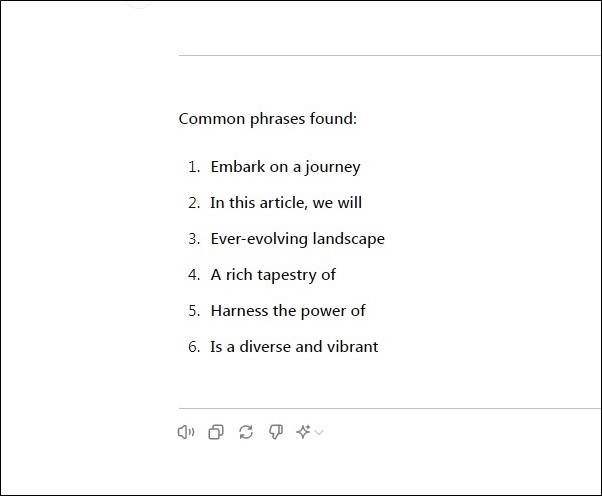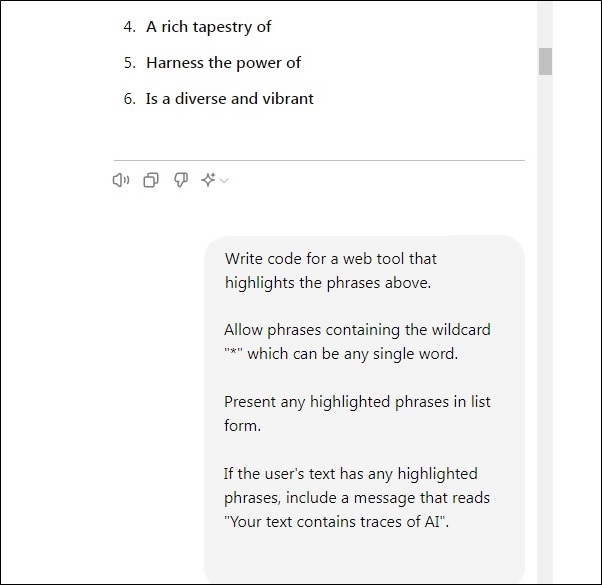Have you heard about the phenomenon of common AI words and phrases? While it’s a nightmare for content creators, you will find that it’s really useful from a detection standpoint.
These well-documented commonalities in text generated by artificial intelligence mean you can put together a basic AI detection tool without any coding skills or any kind of financial outlay.

If your aim is to turn this endeavour into a serious business venture then follow along as we show you how to find the commonalities, build the tool, and market it to the world.
A Quick Reality Check
There are organizations out there who have invested millions in building complex models that study the patterns of human writing to determine whether or not a piece of text was written by an AI chatbot.
Indeed, this is the approach taken by all the big players in AI content detection, and even though users still report false positives, it seems to be a satisfactory solution for the most part.
But this guide will not be going down that path. It’s far too complex. If you want your detector to run on sophisticated algorithms then check out the various guides on the web showing you how to write a Python script.
The Easiest Approach to AI Content Detection
We are going to exploit the repetitive nature of AI chatbots, as this approach is much more accessible to lay people. It might be a bit time consuming, but it doesn’t cost anything.
ChatGPT is by far the most popular large language model out there right now, especially for creating content to be published online, and therefore our detector will revolve around this chatbot.

We need to find the commonalities or “ChatGPTisms” and feed them into our detection tool so that it knows which words and phrases to highlight when the user inputs their text.
Because highlighter tools are able to run on HTML and a little bit of JavaScript, you can ask ChatGPT to write the code. Better still, the tool will execute in the user’s web browser, which means there’s zero strain on your server and the text is processed instantly.
Those last two points will prove critical when it comes to your marketing strategy. You can say “Look, my AI content detector is lightning fast and offers full user privacy as nothing is sent server-side”.
Step 1: Form a list of commonalities
Your AI detector will only be as effective as your list of ChatGPTisms—the stronger the list, the higher the rate at which your tool finds matching words and phrases.
I’ve published lots of posts on AI commonalities, so feel free to read them if you are unfamiliar with this interesting phenomenon. I haven’t discovered enough for a detection tool, but it’s a good starting point.
Or continue scrolling to find out how to conduct your own field research and put together a killer list of AI’s favorite words and phrases.
Focus on article writing
Spotting a ChatGPTism isn’t as hard as it sounds. If you have used the chatbot yourself for written content, you’ve probably already developed a gut instinct for text written by ChatGPT.
It’s particularly noticeable in the realm of article writing, which is really useful since articles are one of the main forms of content that people check for AI.
Words like “elevate” and phrases like “a tapestry of” are well known in the ChatGPT community. But this barely scratches the surface and thus we need to put the chatbot through its paces to uncover more commonalities in AI-written articles.
Ask ChatGPT to rewrite the same article
We can’t identify any similarities if we don’t have any articles to look at. Open ChatGPT, ask it to write an article on a topic of your choice, and prompt it to rewrite the article at least 10 times.
Note: You can’t (well, I couldn’t) get the chatbot to write 10 articles at once, so you have to proceed one-article-at-a-time.
After you have reached your desired quota, ask ChatGPT to analyze the articles together and identify any similar words and phrases between them. This process is all about exposing the ‘bones’ of AI-generated articles.
You should end up with a list of commonalities like this:

Then repeat the process over and over again with other topics to give your AI detector as much coverage as possible. It’s a good idea to build a foundation from the biggest topics to begin with such as travel, fitness and SEO.
And try to stick with parent-level topics in your ChatGPT prompts e.g. “Write an article on SEO” as opposed to “Write an article on keyword research”, otherwise it will take forever to achieve a well-rounded detection tool.
You can always return at a later date to cover those niche-level topics.
Finalize your list
You have to adopt a common sense approach when finalizing your list. After all, lots of words have very high usage in everyday English—weed them out if you think they serve little value in detecting AI content.
Some words really are overused in ChatGPT-generated text (elevate, embrace and delve, to name a few) and deserve to be flagged, but they are fairly exceptional.
Ultimately, your list should primarily comprise of phrases, as it makes your tool look more credible when it’s able to identify an entire string of words linked to AI.
Once your list has legs, it’s time to build a web tool around it. There’s nothing stopping you from jumping to this step with an unfinished list to see how everything works.
Step 2: Get ChatGPT to write the code
We want users to be able to input text and receive a verdict as to the origin of said text. Ironically, ChatGPT is on hand to put this into fruition.
Remember, our tool is unique in that it will work in the user’s web browser rather than run through a server, which means ChatGPT needn’t stray beyond HTML and JavaScript.
Insert a wildcard
The wildcard is perhaps the most complicated part of the tool’s design, and it’s super important for putting your list of ChatGPTisms to work as efficiently as possible.
Why? Many commonalities are variations of the same phrase just with different adjectives and adverbs. For example, “a tapestry of” may appear as:
- A rich tapestry of
- A diverse tapestry of
- A captivating tapestry of
This is easily remedied by writing the phrase as “a * tapestry of” whereby “*” can be any single word. You can imagine how over-bloated your list would become without the wildcard.

Provide feedback
I always recommend aiming for simplicity when it comes to the coding side of things, especially for a basic word/phrase highlighter. This sentiment applies to the feedback element as well.
So, you should instruct ChatGPT to output the text with any ChatGPTisms highlighted and present them in list form for easy reading. And include a message warning the user that their text contains traces of AI (or congratulating them if it doesn’t).
Feel free to provide a richer form of feedback if you see the value in doing so, such as by telling the user the percentage of their text that has been highlighted.
Testing
Not only do you need to test the tool’s UX to ensure users can input text and receive feedback without any problems, you need to check whether it successfully catches traces of AI.
Obviously, the latter comes down to the robustness of your list—put some ChatGPT-written articles through your tool and if it struggles to find matching phrases then continue building up that list.
The tool should become increasingly watertight as you add new phrases, so don’t worry too much if a lot of AI-generated text is slipping through undetected in the early stages.
Step 3: Promote your AI content detector
If the tool is for internal use only, you can go and celebrate the creation of your very own AI content detector! Remember to keep revising and updating your commonalities to strengthen the tool over time.
For those wanting to cash in on their creation, it’s time to explore some tried and tested marketing tactics to help your tool find an audience.
Cold emailing
It wouldn’t be right to recommend spending large sums of money on marketing when this whole guide is about making a tool for free, so we’ll continue with the zero-budget approach (which just so happens to be the best approach).
If you publish AI articles on your site, the last thing you want is for someone to point it out. You can prey on this fear by Googling phrases from your list of ChatGPTisms and contacting sites that you know are churning out AI content.

ChatGPT is a wizard at writing emails, so let the chatbot do all the talking. All you need to do is provide a screenshot of your tool showing traces of AI in their articles.
After scaling your cold emailing efforts, your tool should begin to show signs of traction as more content creators come to you to check that their work bypasses AI detection.
Summary
You can easily build an AI content detection tool for free and with no coding knowledge whatsoever.
Simply prompt chatbots like ChatGPT to rewrite the same piece of text over and over and track the commonalities between them. Then insert your common phrases into a basic phrase highlighter.